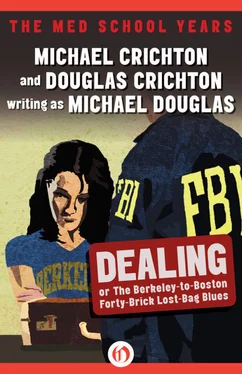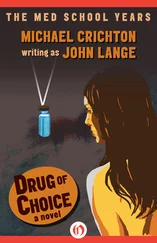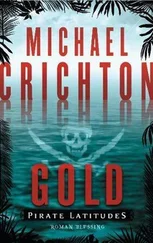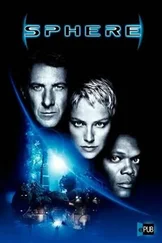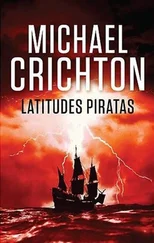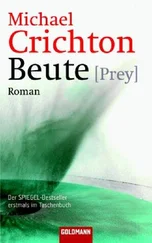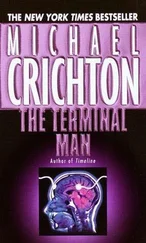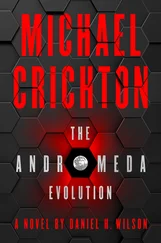SANDRA, SITTING NEXT TO JOHN on the couch, was wiping the smoke out of her eyes when she noticed her watch. “Oh,” she said, jumping up. “It’s time. We’re gonna miss it.” She went over to the television set and turned it on. I was so stoned that I sat there passively and watched her and then the screen, as it glowed to life with the visage of Sally Scott, Eyewitness News, with the Eyewitness News Team investigating a paramount concern to the parents of Boston: teen-age drug abuse.
“Lieutenant Murphy,” Sally Scott asked, as she walked along a table laid out, like a feast, with exhibits. “What is this here?”
“This here is a kilogram of marijuana, which is two point two pounds of the drug. It is dried and pressed into a block for purposes of transportation, as you can see.”
“I see,” Sally Scott said.
“If you bring the camera closer, you might get a better shot,” Lieutenant Murphy said helpfully. The camera came closer. “As you can see, this block of the drug is commonly referred to by traffickers and illicit users as a key or a brick.”
“And this?” Sally Scott asked, moving on.
“Now, this is what the kids buy from the dope peddlers. This is how the drug is sold, in a one-ounce Baggie. An ounce may cost as much as fifty dollars.”
“Fifty dollars!” John said. “Jesus, maybe in Wellesley or someplace.”
“I see,” Sally Scott said. “And how much of this, uh, drug is necessary to make a person, uh…”
“High?” Lieutenant Murphy asked. “Not very much. The drug is smoked in cigarettes, called reefers or joints. Just one of these small cigarettes is enough to make a person suffer all the effects of the marijuana plant.”
“Suffer?” Sandra asked, genuinely puzzled.
John grinned.
Sally Scott said, “And what exactly are these effects?”
“Mostly unpleasant,” Lieutenant Murphy said. “The mouth feels dry and the voice may be painful. The eyes hurt and one may suffer hallucinations. All inhibitions are released and the person under the drug may act in peculiar and bizarre ways.”
“In what ways?” Sally Scott had unusually large eyes.
“Someone on this drug, under its effects, stoned, as the psychologically addicted users say, such a person is capable of almost anything.”
“I certainly am,” Sandra said, and got up and switched the television off.
“Hey,” John said, turning it back on. “Roll a joint, Sandy.” The sound returned just in time to hear Sally Scott ask “… the magnitude of the drug problem in Boston?”
“Very serious,” Murphy said seriously. “There’s no question of that. All reports indicate that the center of drug abuse in the country is shifting from San Francisco to New York and Boston. Boston is now the center.”
“Why is that?” Sally Scott asked.
“The climate,” said John.
“Primarily because of the influx of college students to the Greater Boston area. We have two hundred thousand college students, most of them from out of state. Unfortunately, some of these students deal in drugs.” Murphy paused to get his breath, then went on. “You see, the atmosphere on the college campuses today tends to encourage bizarre behavior, and often the responsible adult on the scene, the administrator, and so forth, will pooh-pooh even illicit activities if they happen to be fashionable. The campuses also provide a gathering place for all types of weirdos, outcasts, and hangers-on who wouldn’t be able to exist in a normal American environment. These types are often among the offenders. Simply by their presence, they assist the growing drug traffic.”
“Oh, Christ,” John said, “are you listening to this bullshit?”
Murphy was gone, and Sally Scott was saying: “… University’s psychopharmacology unit for answers to these and other questions. Doctor, what is the medical evidence on marijuana?”
The doctor was pale and thin and thoughtful-looking. He wore glasses and blinked his eyes a lot, and spoke in little shotgun-bursts. “Well the first thing to say—is that there is very little in the way of—hard medical data on the drug. On the contrary we know remarkably little—about the effects—or the hazards—of this particular compound; however—we can say—that earlier ideas were wrong—and the drug is not addicting—by this we mean—there is no tolerance—phenomenon—and no psychological dependence or physical—uh, dependence—craving—no craving—and we can say the drug does not lead—to heroin or other narcotics.”
“You say heroin or other narcotics. Isn’t marijuana a narcotic?”
“Well, that depends—on your definition—but strictly speaking, a narcotic means—something that produces sleep—from narcos in Greek, ‘to sleep’—but in the usual sense it means pain-killing and sensory-dulling medications—sleeping pills—and these drugs, as you know, are nearly all addicting—the term narcotic—to most people—means addicting drug—though not, of course—to doctors.” Blink, blink.
Sally Scott looked him right in the eye. “How dangerous is marijuana?”
“Well, that depends again—on your definition—an automobile—is pretty dangerous—and so is aspirin, liquor, and cigarettes—the same thing—all medications—all drugs, broadly speaking—are dangerous and you are better off without them. In terms—of purely pleasure-producing drugs—like cigarettes and coffee—and alcohol—we can say that marijuana—so far as we know—may be a better drug to take—for pleasure—that is, safer and less addicting—but then—we know little about it.”
“When you say a better drug…”
“In terms of side effects—long-term damage—something like alcohol, as you know—is a terrible drug—physically addicting—psychologically disrupting—literally a poison to brain cells, a neurotoxin—and yet it is perfectly acceptable—to society.”
“Alcohol is a poison to brain cells?” Sally Scott asked, astonished. “But alcohol is used in all civilizations around the world.”
“Yes,” the doctor said. “That is true.”
After half an hour of this, I got up off the couch and said to John: “Got a lid?”
John raised an eyebrow. “Studying?”
“The exam’s tomorrow,” I said, “and I don’t know a fucking thing about the course.”
John shrugged.
“Well, it’s not Spots and Dots, you know,” I said. Spots and Dots was the toughest course offered by the Fine Arts Department. Modern Western Art 1880–1960. Blind men had been known to pass.
“Top drawer of my dresser,” John said. “But only take one.”
“Yeah, yeah, yeah,” I said. I opened the drawer and took a Baggie, one of the fuller-looking ones. Herbie was particular about his payoffs. When I came back, John said, “By the way, check your desk?”
I shook my head, and went into the other room to check my desk. There was a stack of mail on it; on top, in a cream-colored envelope, some sort of invitation. The handwriting on the front was Annie’s. I tore it open. It was an invitation to attend the Piggy Club Garden Party the next Saturday. I looked at the postmark on the envelope; it had been mailed a week before. Too late to give a negative reply. I went out and threw it in John’s lap. “Did you rig this?”
John looked shocked. “You mean, arrange it?”
“No, dammit, I mean call her up and tell her I was out of town.”
John said, “I knew you’d be back in time.” He smiled. “To accept,” he added.
“Get bent,” I said.
“It’s a peace offering, you know,” John went on. “It means she still likes you.”
“Get bent,” I said again. John was a member of the Piggy Club, and he was having a moment of fun at my expense. We both knew that Annie was now making it with a club member, and we both knew that club members were not permitted themselves to invite women to the parties.
Читать дальше
